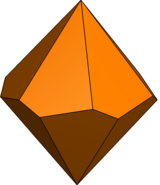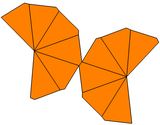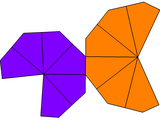|
Trapezohedron
In geometry, an n-gonal trapezohedron, n-trapezohedron, n-antidipyramid, n-antibipyramid, or n-deltohedron[3],[4] is the dual polyhedron of an n-gonal antiprism. The 2n faces of an n-trapezohedron are congruent and symmetrically staggered; they are called twisted kites. With a higher symmetry, its 2n faces are kites (sometimes also called trapezoids, or deltoids).[5] The "n-gonal" part of the name does not refer to faces here, but to two arrangements of each n vertices around an axis of n-fold symmetry. The dual n-gonal antiprism has two actual n-gon faces. An n-gonal trapezohedron can be dissected into two equal n-gonal pyramids and an n-gonal antiprism. TerminologyThese figures, sometimes called deltohedra,[3] are not to be confused with deltahedra,[4] whose faces are equilateral triangles. Twisted trigonal, tetragonal, and hexagonal trapezohedra (with six, eight, and twelve twisted congruent kite faces) exist as crystals; in crystallography (describing the crystal habits of minerals), they are just called trigonal, tetragonal, and hexagonal trapezohedra. They have no plane of symmetry, and no center of inversion symmetry;[6],[7] but they have a center of symmetry: the intersection point of their symmetry axes. The trigonal trapezohedron has one 3-fold symmetry axis, perpendicular to three 2-fold symmetry axes.[6] The tetragonal trapezohedron has one 4-fold symmetry axis, perpendicular to four 2-fold symmetry axes of two kinds. The hexagonal trapezohedron has one 6-fold symmetry axis, perpendicular to six 2-fold symmetry axes of two kinds.[8] Crystal arrangements of atoms can repeat in space with trigonal and hexagonal trapezohedron cells.[9] Also in crystallography, the word trapezohedron is often used for the polyhedron with 24 congruent non-twisted kite faces properly known as a deltoidal icositetrahedron,[10] which has eighteen order-4 vertices and eight order-3 vertices. This is not to be confused with the dodecagonal trapezohedron, which also has 24 congruent kite faces, but two order-12 apices (i.e. poles) and two rings of twelve order-3 vertices each. Still in crystallography, the deltoid dodecahedron[11] has 12 congruent non-twisted kite faces, six order-4 vertices and eight order-3 vertices (the rhombic dodecahedron is a special case). This is not to be confused with the hexagonal trapezohedron, which also has 12 congruent kite faces,[8] but two order-6 apices (i.e. poles) and two rings of six order-3 vertices each. FormsAn n-trapezohedron is defined by a regular zig-zag skew 2n-gon base, two symmetric apices with no degree of freedom right above and right below the base, and quadrilateral faces connecting each pair of adjacent basal edges to one apex. An n-trapezohedron has two apical vertices on its polar axis, and 2n basal vertices in two regular n-gonal rings. It has 2n congruent kite faces, and it is isohedral.
Special cases
SymmetryThe symmetry group of an n-gonal trapezohedron is Dnd = Dnv, of order 4n, except in the case of n = 3: a cube has the larger symmetry group Od of order 48 = 4×(4×3), which has four versions of D3d as subgroups. The rotation group of an n-trapezohedron is Dn, of order 2n, except in the case of n = 3: a cube has the larger rotation group O of order 24 = 4×(2×3), which has four versions of D3 as subgroups. Note: Every n-trapezohedron with a regular zig-zag skew 2n-gon base and 2n congruent non-twisted kite faces has the same (dihedral) symmetry group as the dual-uniform n-trapezohedron, for n ≥ 4. One degree of freedom within symmetry from Dnd (order 4n) to Dn (order 2n) changes the congruent kites into congruent quadrilaterals with three edge lengths, called twisted kites, and the n-trapezohedron is called a twisted trapezohedron. (In the limit, one edge of each quadrilateral goes to zero length, and the n-trapezohedron becomes an n-bipyramid.) If the kites surrounding the two peaks are not twisted but are of two different shapes, the n-trapezohedron can only have Cnv (cyclic with vertical mirrors) symmetry, order 2n, and is called an unequal or asymmetric trapezohedron. Its dual is an unequal n-antiprism, with the top and bottom n-gons of different radii. If the kites are twisted and are of two different shapes, the n-trapezohedron can only have Cn (cyclic) symmetry, order n, and is called an unequal twisted trapezohedron.
Star trapezohedronA star p/q-trapezohedron (where 2 ≤ q < 1p) is defined by a regular zig-zag skew star 2p/q-gon base, two symmetric apices with no degree of freedom right above and right below the base, and quadrilateral faces connecting each pair of adjacent basal edges to one apex. A star p/q-trapezohedron has two apical vertices on its polar axis, and 2p basal vertices in two regular p-gonal rings. It has 2p congruent kite faces, and it is isohedral. Such a star p/q-trapezohedron is a self-intersecting, crossed, or non-convex form. It exists for any regular zig-zag skew star 2p/q-gon base (where 2 ≤ q < 1p). But if p/q < 3/2, then (p − q)360°/p < q/2360°/p, so the dual star antiprism (of the star trapezohedron) cannot be uniform (i.e. cannot have equal edge lengths); and if p/q = 3/2, then (p − q)360°/p = q/2360°/p, so the dual star antiprism must be flat, thus degenerate, to be uniform. A dual-uniform star p/q-trapezohedron has Coxeter-Dynkin diagram
See alsoWikimedia Commons has media related to Trapezohedra.
References
External links |
|||||||||||||||||||||||||||||||||||||||||||||||||||||||||||||||||||||||||||||||||||||||||||||||||||||||||||||||||||||||||||||||||||||||||




















